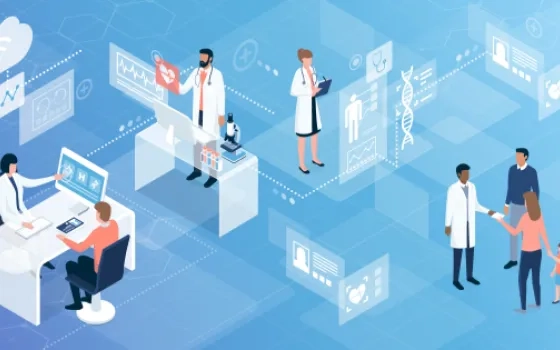The future of the hospital landscape is set to change. We will soon witness an era characterized by the emergence of connected, smart, secure, and sustainable ecosystems – driven by evolving market dynamics and technological advancements. This paradigm shift promises to accelerate the triple aim of healthcare by revolutionizing healthcare delivery, elevating patient experience, improving outcomes, simplifying clinical workflows, and optimizing operational efficiencies.
In this four-part blog series, we will be delving into three key pillars of the hospital of the future, viz., Quality of Care, Operational Excellence, and Great Experiences with a focus on technology advancements and alignment thereof.
Shaping the Future of Hospitals: Key Enablers and Challenges
Hospitals operate in a dynamic and complex healthcare landscape, characterized by a multitude of enablers and challenges. To thrive in this environment, they must navigate various factors that impact their competitiveness, regulatory compliance, operational efficiency, and patient as well as clinician experiences.
Key drivers such as competitive pressure, regulatory requirements, workforce shortages, and heightened consumerism are pushing hospitals towards continuous improvement and innovation. Prioritizing personalized care and access to services to improve patient experiences has always been improvement areas which are vital for hospitals to thrive in a demanding healthcare landscape.
Formidable challenges faced are financial pressures, operational inefficiencies, quality outcomes, technology adoption, and data management. The COVID-19 pandemic has accelerated the adoption of technology, leading to rapid advancements in digital engagement, telemedicine, and data-driven solutions. This highlights the multifaceted nature of the healthcare industry and the imperative for hospitals to adapt, evolve, and deliver high-quality care in an ever-changing landscape.
Key Pillars of Business-Driven Technology Transformation
Application of innovative approaches and technologies aids in improving multiple aspects of healthcare delivery, patient outcomes, and overall system efficiency. In this blog series, we aim to look at new possibilities and opportunities for enhancing the quality, safety, accessibility, and cost-effectiveness of healthcare services.
High Quality Care
In the hospital of the future, continuous improvement in quality of care is paramount, as healthcare institutions strive to provide patient with better outcomes.
- Integrated Informatics: Providing healthcare professionals with precision, compassion, and transformative outcomes through seamless integration of data/systems and actionable insights:
- Longitudinal whole patient record
- Computer Vision AI assisted Diagnostics
- Digitization of clinical/care pathways
- Connected Systems: Interconnected systems leading to universe of synchronized data, seamless collaboration, collaborative expertise, and unified care pathways by tapping into,
- Digitally connected surgical, nursing and laboratory systems
- Robotic surgeries including remote surgeries leveraging the power of 5G.
- Command centers for clinical and operational surveillance
- Connected Ambulances with remote monitoring, video consult, green corridor, etc.
Operational Excellence
Maximizing the utilization of resources, streamlining complex workflows, and ultimately delivering exceptional patient care is of paramount importance for arriving at the hospital of the future. This includes a renewed focus on:
- Digital Operations: To optimize operational efficiency, enhance patient care outcomes, and empower healthcare providers to achieve higher levels of performance and productivity by implementing,
- Digital medical operations, Lab of the Future
- RFID tracking for patients, personnel, and equipment/supplies
- Digital twin for facilities management
- Intelligent Supply Chains: For orchestrating a symphony of precision, ensuring the timely delivery of critical resources, uninterrupted patient care, and a crescendo of optimized operational excellence by capitalizing on,
- Digitally managed inventory
- Connected devices, predictive device maintenance
- Modernization and intelligent automation of supply chain management
- Next-Gen Secure IT Infra: To create a seamlessly connected, patient-centric environment that revolutionizes healthcare delivery and sets new standards of excellence by deploying,
- Software-Defined Networks
- HPC, Hybrid Cloud & Data Centers
- Cybersecurity, SOC/NOC, and Command Centers
- Sustainability / ESG: Transform your hospitals with harmonious fusion of green energy systems, water conservation strategies, resource optimization initiatives, and waste management innovations converge, shaping a holistic healing environment that champions both patient well-being and the preservation of our precious planet.
Great Experiences
To provide personalized and convenient experiences for patient’s technologies hospital are adopting innovative smart spaces, digital engagement, and telehealth solutions.
- Smart Generic Spaces:Intelligent electromechanical and digital design transforming the physical spaces (buildings, parking, lobbies, elevators, hallways, meeting rooms, cafeterias, restrooms, et al) into astute ecosystems, tailored to optimize experiences and sustainability.
- Smart Medical Spaces:Combing medical protocols with smart spaces technology, medical spaces such as OR, ED, ICU/NICU, radiation therapy rooms, patient rooms, labor rooms, etc., can be transformed into sanctuaries of care, connectivity, and comfort.
- Digital engagement: Drive patient empowerment, foster collaborative care, facilitate seamless communication with personalized immersive experiences, make informed decision-making, and enhance well-being by plugging in
- DFD and AI-assisted Workflow Digitization
- Telehealth & Remote patient monitoring
- Immersive experiences (AR/VR) for virtual care and CME / training, etc.
Technologies Empowering the Future of Healthcare
Harnessing emerging technologies will play a vital role in the digital transformation of hospitals, enabling the development of smart hospitals of the future. By harnessing the power of cloud computing, AI (Artificial Intelligence), IoMT (Internet of Medical Things), MEMS (Micro-electromechanical Systems), robotics, 5G, metaverse, blockchain, and more, healthcare providers can enhance patient care, improve operational efficiency, and drive innovation in healthcare delivery. These advancements in smart hospitals aim to improve patient outcomes, enhance patient experiences, and optimize healthcare resource utilization. They promote patient-centric care, reduce healthcare costs, and enable individuals to actively participate in managing their health.
As the healthcare landscape evolves, the integration of technology, connectivity, and personalized care will reshape the future of healthcare, transforming the way we deliver and experience healthcare services. The vision of smart hospitals without walls and hospital at home holds tremendous potential in revolutionizing healthcare and bringing care closer to patients' lives.
Global HOTF Examples
Healthcare organizations across the globe are investing in leveraging cutting-edge technologies to drive modernization of hospitals and care settings. Some notable examples include the NEOM project (Saudi Arabia) investing heavily into building digitally advanced hospitals with a focus on accessibility and next-gen tech; UC Davis Health revamping its entire footprint (Sacramento) with smart buildings, connected care and an innovation district as part of its 2030 vision; CSMRC (Doha) launching digital-only facilities deploying robotics, computer-aided ,surgery, and digital imaging technology; Health systems like Thumbay group (Dubai), Yashoda Hospitals (India) implementing virtual hospitals leveraging AR/VR/Metaverse for immersive experiences.
Looking Forward
Smart hospitals of the future will go beyond digital transformation to truly harness the power of "phygital" technology advancements for enabling next-gen healthcare delivery, going even beyond the hospital setting. The future of smart hospitals is headed towards a paradigm shift where healthcare is no longer confined within the traditional hospital walls. Hospitals without walls and hospital/care at home is gaining prominence, boosted by COVID, and driven by advancements in technology as well as the ongoing desire to provide right care at the right place at the right time.






























